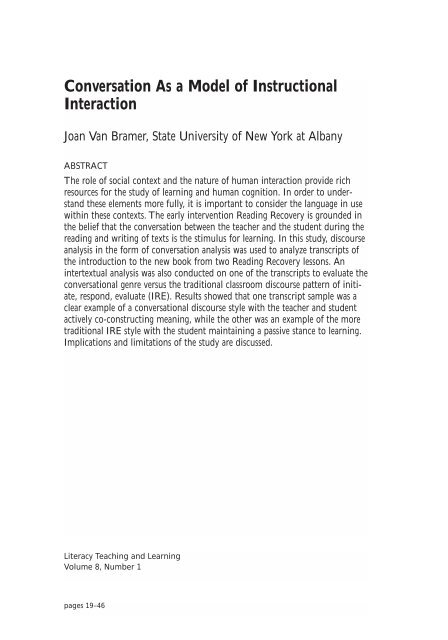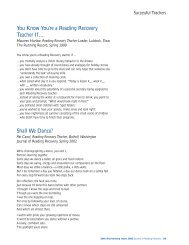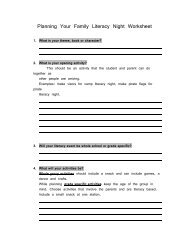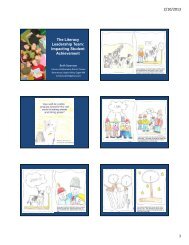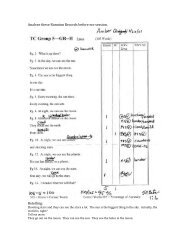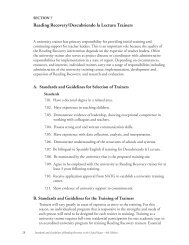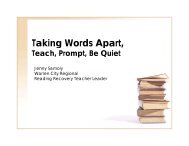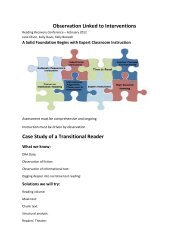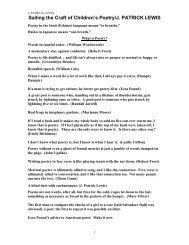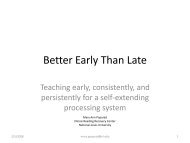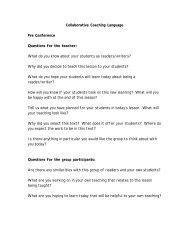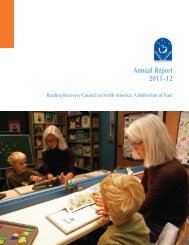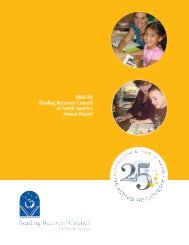Conversation As a Model of Instructional Interaction - Eric
Conversation As a Model of Instructional Interaction - Eric
Conversation As a Model of Instructional Interaction - Eric
Create successful ePaper yourself
Turn your PDF publications into a flip-book with our unique Google optimized e-Paper software.
layout-8/l-2003 1/7/04 12:29 PM Page 20Literacy Teaching and LearningVolume 8, Number 1Teaching is essentially a matter <strong>of</strong> facilitating learning, andwhere that learning depends on communication between theteacher and the learner, the same principles apply as in anysuccessful conversation. The aim must be the collaborativeconstruction <strong>of</strong> meaning, with negotiation to ensure thatmeanings are mutually understood.(Wells, 1986, p. 101)The role <strong>of</strong> discourse in learning, particularly in educational settings, cannot beunderstated. Analyzing discourse helps us understand how knowledge is createdwithin human social interactions and, as Jaworski and Coupland (1999) suggest,deconstruct how particular texts come to be structured as they do, with alltheir social and political implications. From this perspective, language use isviewed as a form <strong>of</strong> social practice (Fairclough, 1999). Understanding discoursein this way may help educators provide the instructional conversations mostbeneficial to all students.The purpose <strong>of</strong> this paper is to, through discourse analysis, consider theprinciples <strong>of</strong> conversation within an educational framework. Specifically, I willexamine the interactions within a one-to-one tutoring setting to determinewhether or not the principles <strong>of</strong> conversation are being applied and to describehow meaning is being co-constructed.THEORETICAL FRAMEMy understanding <strong>of</strong> conversation as instruction is informed by Jaworski andCoupland’s (1999) research regarding conversation analysis and research thatdescribes what is meant by conversation within educational frameworks. In thefollowing two sections, I provide background on these perspectives.<strong>Conversation</strong> AnalysisJaworski and Coupland (1999) describe several key features <strong>of</strong> conversationanalysis. These features include openings and closings, adjacency pairs, topicmanagement and topic shift, conversational repairs, showing agreement anddisagreement, and mechanisms <strong>of</strong> turn taking which they say is probably themost central. Within this social practice, there are well-established scripts thatspeakers follow with clearly defined roles. In adjacency pairs, for example, twoutterances are linked, with the first actually defining how the second utteranceis constructed and with the anticipation that the second will fill that slot asexpected. Such pairs might include question-answer, greeting-greeting, or <strong>of</strong>feracceptance/refusal.In these examples the first utterance leads to a specific type<strong>of</strong> utterance in response.20
layout-8/l-2003 1/7/04 12:29 PM Page 26Literacy Teaching and LearningVolume 8, Number 1The two students in the study were selected randomly from each teacher’scaseload <strong>of</strong> Reading Recovery students. They were selected for ReadingRecovery in the fall <strong>of</strong> their first-grade year because <strong>of</strong> their status as beingamong the population <strong>of</strong> students experiencing the most difficulty with learningto read and write.Data SourcesParticipant observation, field notes, audiotaping, and transcription served as theresearch tools. The researcher observed and audiotaped the teacher’s book introductionand the conversation between the teacher and the child during theintroduction. Field notes were used mainly as a tool for comparison since theaudiotapes and transcripts provided much more detailed information. <strong>As</strong> anobserver, the researcher sat behind the teacher and child in an attempt to be asunobtrusive as possible.Data AnalysisData that were gathered through participant observation, field notes, audiotapes,and transcripts were analyzed in two phases using discourse analysis. Thefirst phase included the conversation analysis <strong>of</strong> transcripts <strong>of</strong> the book introductionand the teacher-child verbal interaction during the introduction. Thesecond phase involved an analysis <strong>of</strong> intertextuality for one <strong>of</strong> the transcripts.During the first phase, the transcript for each teacher and her student wasanalyzed for characteristics typical <strong>of</strong> genuine conversation. Features such asmechanisms for turn taking, openings and closings, adjacency pairs, topic managementand topic shift, conversational repairs, and showing agreement anddisagreement were noted for each <strong>of</strong> the two transcripts. I explored additionalevidence <strong>of</strong> conversation by searching for instances <strong>of</strong> these three things: participantschecking for understanding, showing signs <strong>of</strong> cooperation, and buildingupon previous utterances.The second phase <strong>of</strong> the analysis considered the nature <strong>of</strong> intertexuality <strong>of</strong>one <strong>of</strong> the transcripts. The goal <strong>of</strong> the analysis was to understand how two differentdiscourse genres appeared within one lesson excerpt and to consider howthat might have affected the instructional conversation. The transcript wasassessed for evidence <strong>of</strong> the traditional initiate, respond and evaluate (IRE)instructional genre (Cazden, 1988) and a less typical conversational instructionalmodel. Specific consideration was given to speakers’ rights, the teacher’srole, and the teacher’s speech style—elements suggested by Cazden as havingthe potential for significant positive cognitive and social impact on students.26
layout-8/l-2003 1/7/04 12:29 PM Page 27<strong>Conversation</strong> <strong>As</strong> a <strong>Model</strong> <strong>of</strong> <strong>Instructional</strong> <strong>Interaction</strong>Van BramerFINDINGSCharacteristics <strong>of</strong> <strong>Conversation</strong> in New Book OrientationsThe goal <strong>of</strong> the teacher’s book introduction is to make the book accessible tothe child. The new book is carefully selected based upon the child’s currentcapabilities so that there are just a few new things to learn, and it is carefullyintroduced to provide a framework <strong>of</strong> meaning to scaffold the successful reading.<strong>As</strong> stated by Clay and Cazden (1990), “What may seem like casual conversationalexchanges between teacher and pupil are based on deliberate teachingdecisions for a particular child” (p. 210).Therefore, the conversation during the book introduction is critical for thejoint construction <strong>of</strong> meaning that will allow the child to read the book successfully.Teacher modeling <strong>of</strong> how to actively construct meaning from text duringthe introduction will allow the child to take over this task while becoming aconstructive rather than passive learner.Appendix A explains the transcription conventions, and Appendixes B andC contain the transcripts that were analyzed. In the first set <strong>of</strong> findings, theanalysis refers to specific lines in each <strong>of</strong> the two transcripts for evidence or lack<strong>of</strong> evidence <strong>of</strong> the characteristics <strong>of</strong> conversation to be discussed. The second set<strong>of</strong> findings demonstrates the elements <strong>of</strong> intertextuality in terms <strong>of</strong> the traditionalinstructional discourse <strong>of</strong> IRE versus the less institutionalized discourse<strong>of</strong> everyday conversation.<strong>Conversation</strong> Analysis <strong>of</strong> Transcript 1<strong>As</strong> mentioned earlier, conversation analysis centers upon certain characteristicfeatures <strong>of</strong> conversation. Specific features are demonstrated from transcriptexcerpts below. Bracketed conversation indicates the teacher and child arespeaking at the same time, while = indicates contiguous utterances and ( ) indicatestalk that is unheard or is in doubt. The transcript is arranged to showwhen the overlapping occurred. The numbers correspond to the lines in thetranscript included in Appendix B.In Transcript 1, Lines 1–3, the teacher (T) has a clear opening which makesa connection with an earlier book read by the child (C) :1 T: Now, you remember we’ve been reading an ABC book, child’sname, about the zoo?=2 C: = Yeah.3 T: And all the animals in the zoo?This sample also shows an adjacency pair that could be considered27
layout-8/l-2003 1/7/04 12:29 PM Page 30Literacy Teaching and LearningVolume 8, Number 1insists that cheetahs have stripes as well as spots, the teacher uses “oh” in whatcould be considered a disjunction and surprise at not sharing a point <strong>of</strong> view orknowledge state:15 T: They do?16 C: Yeah.=17 T: =Oh golly – I thought they had spots.18 C: They have stripes too.Another use <strong>of</strong> “oh” signals that the teacher is now in the role <strong>of</strong> the listener:37 C: I picked up a tiger once.38 T: Oh.39 C: A baby.40 T: Ahh. W-41 C: [It doesn’t bite.There are many examples throughout Transcript 1 that lead one to concludethat this interaction had many elements <strong>of</strong> everyday conversation. <strong>As</strong>idefrom the examples given above, there were examples <strong>of</strong> the teacher picking upon earlier threads in the talk (Lines 77–79) and building upon shared experiences(Lines 74–78), much like one would do in daily conversation.74 T: =They’re otters.75 C: I’ve seen otters before.76 T: Have you seen otters? Yeah, you might have seen otters. I’ve seenone around Vermont when I’ve been hiking – and77 C: [I hike every day.77 T: Do you hike every day? There’s the animal that you thought wewould see.78 C: Yup – and I was right.79 T: Right El:a:phants.Transcript 1 clearly provided an example within which conversation couldbe analyzed within the educational setting <strong>of</strong> the Reading Recovery lesson. Inthis sample, both teacher and child viewed themselves as active co-constructors<strong>of</strong> meaning. They worked toward mutual understanding and built upon eachother’s contributions to clarify and extend that construction <strong>of</strong> meaning. I willnow turn to Transcript 2 (Appendix C) for analysis.Analysis <strong>of</strong> Transcript 2Transcript 2 was selected as a contrast to Transcript 1. This sample book introduction,though provided by an experienced Reading Recovery teacher who has30
layout-8/l-2003 1/7/04 12:29 PM Page 31<strong>Conversation</strong> <strong>As</strong> a <strong>Model</strong> <strong>of</strong> <strong>Instructional</strong> <strong>Interaction</strong>Van Bramerhad successful experiences with students, is very different from the first sample.This analysis explores those differences regarding the evidence <strong>of</strong> conversationas a model <strong>of</strong> interaction and the nature <strong>of</strong> cooperation between the teacherand the student in co-construction <strong>of</strong> meaning.One striking difference between the two samples is the amount <strong>of</strong> talk bythe child (C). In Transcript 1 there were a few one-word responses, but most <strong>of</strong>the child’s utterances were complete sentences as seen in excerpts above. InTranscript 2, however, the student typically responded with one word withoutfurther elaboration:20 C: Steak.21 T: It looks like it could be steak. What are those strips though?They’re called (0.3) Remember they’re called bacon.22 C: Yeah, bacon.23 T: Bacon. And. Uh. Look, here’s something new.24 C: Milk.25 T: Could be milk.26 C: Water?The child in Transcript 1 initiated some talk so that topic control and turntaking were mutually controlled by student and teacher. In Transcript 2, unlikeeveryday conversation, one participant, the teacher (T), seemed to control topicchoice and turn allocation. There was no evidence <strong>of</strong> latching or joint productionwith the recycling <strong>of</strong> items or phrases across turns. There were no instances<strong>of</strong> the child overlapping the teacher’s talk except for two instances where thechild started to read from the text and the teacher asked the child to wait:3 T: Yes because Owen is asleep here.4 C: [Owen is asleep. (Child reads this frombook)5 T: <strong>As</strong>leep. But here is where he – where Owen wakes up.6 [(Child starts to read)7 T: [Oh wait a minute…Although the teacher’s goal was to engage the child in some form <strong>of</strong> conversation,it was clear that this child, as a result <strong>of</strong> the way the teacher had structuredthe interaction, had a very different view <strong>of</strong> his role in the interactionwhen compared to the child in Transcript 1. The child in Transcript 2 did nottake an active role or responsive stance to the teacher’s utterances. Rather thechild seemed to be attempting to give the right answer—the answer that theteacher was looking for. There did not seem to be the co-construction <strong>of</strong> meaningand level <strong>of</strong> cooperation in Transcript 2 that there was in Transcript 1. Theteacher in the second sample seemed to operate more in the traditional IRE discoursepattern, with the child <strong>of</strong>fering one-word responses and then anticipat-31
layout-8/l-2003 1/7/04 12:29 PM Page 32Literacy Teaching and LearningVolume 8, Number 1ing some form <strong>of</strong> evaluation from the teacher:26 C: Water?27 T: We’ll see it could be either milk or water. We’ll see when we readthe story. Is it – Look it. Is it – is everything empty? Do youthink Owen is hungry or not hungry now?28 C: Hungry.29 T: You think he’s still hungry?30 C: Not hungry.31 T: Not hungry anymore, is he – is he?There was additional evidence that this child was tentative in his responseswhen the teacher attempted to engage him with the meaning <strong>of</strong> the storythrough the use <strong>of</strong> questioning. The child again seemed to be searching for thecorrect answer to the teacher’s questions, and the interaction seemed more likea testing situation than a conversation. For example:11 T: Looks like he’s got jam and some (0.6)12 C: Sandwich?13 T: Looks like a sandwich. See how it’s kind <strong>of</strong> toasted there. It lookslike that might be toast. But we’ll see when we read the storywon’t we? Whether it’s a sandwich or toast. Oh here’s some –What do you think that could be in that bowl?14 C: Milk.15 T: Milk he would have put in. And what do you think he’s puttingthe milk in with?16 C: Umm. Soup?17 T: It doesn’t look like soup, does it? What could it be for br-18 C: [Cereal?Because the child <strong>of</strong>fered so little verbally, there were few opportunities forthe teacher to link back to previous utterances or build upon personal experiences.The child did not appear to see himself as an active learner but remainedpassive in his role as receiver <strong>of</strong> information. He did not make verbal connectionsto his previous experiences and prior knowledge or use these experiencesor knowledge to work actively to co-construct meaning with the teacher.<strong>As</strong> a result <strong>of</strong> an in-depth discourse analysis <strong>of</strong> the transcripts, a clearerunderstanding <strong>of</strong> the role <strong>of</strong> instructional conversations emerged. The socialnature <strong>of</strong> the co-construction <strong>of</strong> meaning became more obvious as both theteacher and the child contributed or failed to contribute to the conversation. Itbecame clear that the discourse genre used by the teacher affected the type andamount <strong>of</strong> oral response <strong>of</strong>fered by the child.32
layout-8/l-2003 1/7/04 12:29 PM Page 33<strong>Conversation</strong> <strong>As</strong> a <strong>Model</strong> <strong>of</strong> <strong>Instructional</strong> <strong>Interaction</strong>Van BramerDiscourse Style in Reading Recovery Lessons Examined<strong>As</strong> stated earlier in this paper, Jaworski and Coupland (1999) describe the goal<strong>of</strong> discourse analysis as being the deconstruction <strong>of</strong> how particular texts havecome to be formed as they are and with what social and political implications.They go on to consider the analysis <strong>of</strong> text in terms <strong>of</strong> how we recognize theinfusion <strong>of</strong> one genre into another. Fairclough (1999) argues that intertextualanalysis is an important aspect <strong>of</strong> discourse analysis because it bridges the gapbetween text and the social context. Therefore, it is helpful to study the types <strong>of</strong>discourse use in particular contexts.The goal <strong>of</strong> this section is to conduct an intertextual analysis <strong>of</strong> Transcript1. The analysis will focus upon the blending <strong>of</strong> the genre <strong>of</strong> traditional institutionalclassroom lesson discourse and the discourse <strong>of</strong> the everyday informalconversational genre. Each <strong>of</strong> these genres has a typical specified position forsubjects. The formal institutional setting traditionally positions the teacher asthe controller <strong>of</strong> the talk, while the informal style <strong>of</strong> everyday conversation ismore cooperative and mutually controlled. Since the focus <strong>of</strong> this paper hasbeen the discussion <strong>of</strong> Reading Recovery as implementing a conversationalmodel <strong>of</strong> instruction, I examined whether there was an intertextual quality tothe instruction, departing from the more traditional genre toward a more socioconstructivistinstructional model <strong>of</strong> informal conversation.This analysis focused upon the three areas <strong>of</strong> change in instructional discoursefeatures that Cazden (1988) advocates. The first feature is speakingrights. Instead <strong>of</strong> the traditional model <strong>of</strong> the student waiting to be called on,the student has some control over when to initiate speaking. The student helpsin the management <strong>of</strong> turn taking.The second feature is that <strong>of</strong> the teacher’s role. This calls for a differentconception <strong>of</strong> knowledge and teaching that allows the teacher to move awayfrom a pattern <strong>of</strong> constant questioning to other forms <strong>of</strong> speaking such as theuse <strong>of</strong> declarative statements, reflective restatements, invitations to elaborate,and instances <strong>of</strong> silence. There is also a greater use <strong>of</strong> wait time so that studentshave opportunities to contribute and react more and teachers become moreadept at using student responses. The construction <strong>of</strong> meaning becomes morecooperative with students and teachers as partners in the construction.The third feature is speech style. The teacher’s language will be “moreexploratory and less final draft” (Cazden, 1988, p. 61). It will be more“unplanned than planned” (p. 61). This will be a necessity if the instruction istruly to become more like conversation since in conversation each utterancebuilds upon the previous utterance. The teacher must build upon the child’scontributions if the child is to see himself as an active participant.The first area to be considered is speaking rights in terms <strong>of</strong> turn taking.Early in the transcript (Lines 1–8) there seems to be a more traditional model<strong>of</strong> discourse similar to the IRE pattern. The teacher asks a question, the child33
layout-8/l-2003 1/7/04 12:29 PM Page 34Literacy Teaching and LearningVolume 8, Number 1responds, and the teacher evaluates or follows with another question. The turntaking appears to be controlled by the teacher. <strong>As</strong> the transcript goes on, however,there are more instances <strong>of</strong> the child initiating comments, as seen in Lines54–65 and Lines 72–87 showing the child’s overlapping utterances and in Lines79 (Yup-I was right.) and 81 (I’m the man!) evaluating his own responses. Thechild appears to be taking on more <strong>of</strong> a shared responsibility for the initiation<strong>of</strong> turns in these instances that is more characteristic <strong>of</strong> conversational discourse.The second discourse feature to signal change is the teacher role. <strong>As</strong> mentionedabove, at first the sample seems to follow the traditional role with theteacher initiating through questioning and then evaluating the child’s responseas in Lines 1–8. There is soon a shift though, which shows the teacher’s rolechanging. Here, instead <strong>of</strong> questioning, the teacher begins to use other types <strong>of</strong>utterances such as declarative statements in Lines 9 (Yeah. I see something onthe front cover.) and 11 (It is like a cheetah. Cheetahs are big cats. This happensto be called a tiger). Line 13 is more <strong>of</strong> a reflection (I have trouble keepingthem apart. I can remember that a tiger has stripes. That’s how I try to rememberthe tiger – because he has stripes). There are also examples <strong>of</strong> invitations toelaborate such as in Line 46 (…Let’s see what else) and Line 48 (Oh. Let’s seewhat else we could see). The teacher uses several conversational markers as inLine 38 (Oh), Line 40 (Ahh), and Line 44 (Hum) to manage the conversationand to invite additional talk from the child. <strong>As</strong> the sample goes on, the childalso begins to comfortably initiate questions for the teacher as seen in Lines 57,67, and 73. Further analysis shows that the teacher seems to switch back to themore traditional IRE pattern in places where she feels the need to check on thechild’s understanding <strong>of</strong> a concept (Lines 70–72) but weaves this more traditionalformat in only on occasions when deemed necessary.The third feature <strong>of</strong> change noted by Cazden is speech style that is moreunplanned or open-ended. Again, as the sample evolves, there appears to be evidence<strong>of</strong> this type <strong>of</strong> speech style. In Line 17 (Oh golly – I thought they hadspots.) the teacher is able to let the child’s insistence that tigers have spots gowithout evaluation and move on in the conversation. In Line 46 (Oh, that’sgood because they like to live – free, don’t they? Let’s see what else) she is ableto respond to the child’s discussion about freeing the animal and then focus hisattention back to the book in a manner that allowed the conversation to flowsmoothly. <strong>As</strong> the sample develops, the teacher appears to form her questions asextensions <strong>of</strong> the child’s utterances (e.g., Lines 76, 78, 86, and 90) rather thanfrom some preconceived agenda. In Line 24 the child starts to construct a personalnarrative, and the teacher, as she sees the need, takes more control withan overlapping utterance to bring the child back to the book discussion.In conclusion, there appears to be clear evidence <strong>of</strong> intertextuality in thesample with a blending <strong>of</strong> the more traditional school institutional genre and34
layout-8/l-2003 1/7/04 12:29 PM Page 35<strong>Conversation</strong> <strong>As</strong> a <strong>Model</strong> <strong>of</strong> <strong>Instructional</strong> <strong>Interaction</strong>Van Bramerthe less formal genre <strong>of</strong> everyday conversation. Using Cazden’s model <strong>of</strong> changein discourse features as a signal <strong>of</strong> a shift from the traditional IRE discourse tothe more informal discourse <strong>of</strong> everyday conversation provides support for theintertextuality <strong>of</strong> the sample. There is strong evidence that this sample hasshifted away from the traditional IRE format to a greater emphasis on conversationas a model <strong>of</strong> instructional interaction.DISCUSSIONUsing the research from conversation analysis and the sociocultural perspectivein educational settings, there is evidence from the study that in Transcript 1 aconversational form <strong>of</strong> interaction was taking place and that the teacher andstudent were cooperating to construct meaning. The sample shows that theteacher and student viewed themselves as active participants working togetherto build and extend their understanding <strong>of</strong> the text. The intertextual analysis <strong>of</strong>this sample also showed that though there were a few instances <strong>of</strong> the more traditionalIRE model, there was also evidence <strong>of</strong> a shift to a conversational model<strong>of</strong> instructional interaction where teacher and student worked collaboratively,actively contributing and building upon each others utterances.In Transcript 2 there was less evidence <strong>of</strong> a conversational model and theinteraction resembled a traditional IRE format. In this sample, the child didnot appear to view his role in learning as active but rather as passive, receivingknowledge from the teacher and searching for the correct answer that theteacher was expecting to hear. The construction <strong>of</strong> meaning appeared to beone-sided, with the teacher controlling the turn allocations as well as the informationand topic management.Within each sample the active or passive stance <strong>of</strong> the student appears criticalto the development <strong>of</strong> the discourse, and the manner in which the teacherstructures the interaction appears to affect the stance taken by the student.Some insights regarding this phenomenon may be gained from Johnston’s(1999) discussion <strong>of</strong> “constructed versus received knowing” (p. 31). He states:“Received knowers feel that knowledge is ‘out there’ and that someone inauthority will be able to give them the knowledge they need to receive” (p. 31).In Transcript 2 the student seems to be operating under this notion, waiting forthe teacher to give him the needed information and contributing only whenasked a specific question. His response then is given in terms <strong>of</strong> what he perceivesto be the right answer as expected by the teacher. The traditional model<strong>of</strong> instruction where classroom discourse follows an IRE format reinforces thistype <strong>of</strong> responding.Conversely, Johnston, in describing constructed knowers, says: “Constructedknowers value conversations as a means <strong>of</strong> learning, particularly conversationsin which people share not-quite-fully formed ideas in the process <strong>of</strong>35
layout-8/l-2003 1/7/04 12:29 PM Page 36Literacy Teaching and LearningVolume 8, Number 1collaboratively constructing meaning” (p. 31). The child in Transcript 1 clearlyappears to take this more active stance to learning. He seems to see conversationas a means <strong>of</strong> sharing and clarifying ideas and views himself as a contributorto the conversation. In this model <strong>of</strong> learning, the teacher has to have amore informed theory <strong>of</strong> how human cognition develops within social contexts.This study creates the need for further research regarding the effects <strong>of</strong> aconversational model <strong>of</strong> instruction on student learning. Within the specificcontext <strong>of</strong> this study, additional research is needed to explore the affect <strong>of</strong> conversationon the co-construction <strong>of</strong> meaning needed for the successful reading<strong>of</strong> a new book. This will be done in a follow-up study to be completed in thenear future.This study also raises new questions. What can be considered genuine conversation?Is the type <strong>of</strong> conversation in instructional settings genuine conversationor is it some form <strong>of</strong> simulated conversation? Since the conversation thatoccurs within instructional settings has an instructional purpose or goal interms <strong>of</strong> what is to be learned by the student, does that make it less genuineand more simulated? Perhaps this type <strong>of</strong> conversation could be consideredguided conversation, where there are elements <strong>of</strong> informal everyday conversation,but there is also an element <strong>of</strong> guidance by the teacher who is attempting tolead the student to new understandings. This view would contribute to thehighly complex nature <strong>of</strong> the interaction and the discourse use within thiscontext.There are obvious limitations to this study due to the small number <strong>of</strong>teachers and students involved and the limited number <strong>of</strong> transcript samples. Itmay provide a starting point, though, for future studies with more teachers andstudents. Since this study focused on a small part <strong>of</strong> the Reading Recovery lesson,future studies could look at other aspects <strong>of</strong> the lesson in terms <strong>of</strong> conversationalinteraction. Classroom studies <strong>of</strong> conversational interaction would alsocontribute to further understandings regarding impact on student learning andthe need for quality pr<strong>of</strong>essional development for teachers.CONCLUSIONThe complexity <strong>of</strong> instructional conversation that allows for constructive knowerscreates a demand for expertly trained teachers. These types <strong>of</strong> conversationsare absolutely necessary for the development <strong>of</strong> thoughtful literacy, especiallyfor students at risk. Yet these conversations do not develop easily with studentswho have taken a passive stance to learning. Clay (1991) considers such childrenwhen she statesThe reading process will be learned haltingly, until he (the unresponsivechild) is confident enough to respond in the troublesome area.Coaxing that is not carping, support that is not demanding, confidence36
layout-8/l-2003 1/7/04 12:29 PM Page 37<strong>Conversation</strong> <strong>As</strong> a <strong>Model</strong> <strong>of</strong> <strong>Instructional</strong> <strong>Interaction</strong>Van Bramerin him that does not deny the reality <strong>of</strong> his sense <strong>of</strong> inadequacy, theseare the fine distinctions that must determine the teacher’s behaviourand attitude towards the unresponsive child. (p. 59)Only highly trained and skilled teachers who are thoughtful about instructionaldiscourse can begin to provide these complex models <strong>of</strong> instructionalinteraction.REFERENCESBakhtin, M. M. (1999). The problem <strong>of</strong> speech genres. In A. Jaworski & N.Coupland (Eds.), The discourse reader (pp. 121–132). New York:Routledge.Cameron, D. (1999). Performing gender identity. Young men’s talk and theconstruction <strong>of</strong> heterosexual masculinity. In A. Jaworski & N. Coupland(Eds.), The discourse reader (pp. 442–458). New York: Routledge.Cazden, C. B. (1998). Classroom discourse. Portsmouth, NH: Heinemann.Clay, M. M. (1991). Becoming literate: The construction <strong>of</strong> inner control.Portsmouth, NH: Heinemann.Clay, M. M. (1998). By different paths to common outcomes. York, ME:Stenhouse.Clay, M. M., & Cazden, C. B. (1990). A Vygotskian interpretation <strong>of</strong> ReadingRecovery. In L. C. Moll (Ed.), Vygotsky and education (pp. 206–222). NewYork: Cambridge University Press.Fairclough, N. (1999). Linguistic and intertextual analysis within discourseanalysis. In A. Jaworski & N. Coupland (Eds.), The discourse reader (pp.183–212). New York: Routledge.Jaworski, A., & Coupland, N. (1999). The discourse reader. New York:Routledge.Johnston, P. (1999). Unpacking literate achievement. In J. S. Gaffney & B. J.<strong>As</strong>kew (Eds.), Stirring the waters: The influence <strong>of</strong> Marie Clay (pp. 27–46).Portsmouth, NH: Heinemann.Klein, A. F., Kelly, P. R., & Pinnell, G. S. (1997). Teaching from theory:Decision making in Reading Recovery. In S. A. Stahl & D. A. Hayes(Eds.), <strong>Instructional</strong> models in reading (pp. 161–179). Mahwah, NJ:Lawrence Erlbaum.Lyons, C. A., Pinnell, G. S., & DeFord, D. E. (1993). Partners in learning:Teachers and children in Reading Recovery. New York: Teachers College Press.Moll, L. C. (1994). Literacy research in community and classroom: A socioculturalapproach. In R. D. Ruddell, M. R. Ruddell, & H. Singer (Eds.),Theoretical models and processes <strong>of</strong> reading (pp. 179–207). Newark, DE:International Reading <strong>As</strong>sociation.37
layout-8/l-2003 1/7/04 12:29 PM Page 38Literacy Teaching and LearningVolume 8, Number 1Nelson, K. (1996). Language in cognitive development: The emergence <strong>of</strong> themediated mind. New York: Cambridge University Press.Peyton-Young, J. (2000). Boy talk: Critical literacy and masculinities. ReadingResearch Quarterly, 35(3), 312–337.Roehler, L. R., & Duffy, G. G. (1991). Teachers’ instructional actions. In M.L.Kamil, P. Pearson, P. Mosenthal, & R. Barr (Eds.), The handbook <strong>of</strong> readingresearch (Vol. II, pp. 861–883). Mahway, NJ: Longman.Rog<strong>of</strong>f, B. (1990). Apprenticeship in thinking. New York: Oxford UniversityPress.Schegl<strong>of</strong>f, E. A., & Sacks, H. (1999). Opening up closings. In A. Jaworski &N. Coupland (Eds.), The discourse reader (pp. 263–274). New York:Routledge.Schiffrin, D. (1999). Oh as a marker <strong>of</strong> information management. In A.Jaworski & N. Coupland (Eds.), The discourse reader (pp. 275-288). NewYork: Routledge.Vygotsky, L. S. (1978). Mind in society: The development <strong>of</strong> higher psychologicalprocesses. Cambridge, MA: Harvard University Press.Wells, G. (1986). The meaning makers: Children learning language and usinglanguage to learn. Portsmouth, NH: Heinemann.Wilkinson, L. C., & Silliman, E. R. (2000). Classroom language and literacylearning. In M. Kamil, P. B. Mosenthal, P. D. Pearson, & R. Barr (Eds.),The handbook <strong>of</strong> reading research (Vol. III, pp. 337–360). Mahwah, NJ:Lawrence Erlbaum.38
layout-8/l-2003 1/7/04 12:29 PM Page 39<strong>Conversation</strong> <strong>As</strong> a <strong>Model</strong> <strong>of</strong> <strong>Instructional</strong> <strong>Interaction</strong>Van BramerAPPENDIX ATranscription ConventionsOverlapping utterances [Contiguous utterances =Short pause –Extension <strong>of</strong> sound <strong>of</strong> speech delivery :Loud talkCapital LettersTalk unheard or in doubt ( )39
layout-8/l-2003 1/7/04 12:29 PM Page 40Literacy Teaching and LearningVolume 8, Number 1APPENDIX BCONVERSATION TRANSCRIPT 1(teacher and child book introduction)T - teacherC - student1 T: Now, you remember we’ve been reading an ABC book. Trey, aboutthe zoo?=2 C: = Yeah.3 T: And all the animals in the zoo? =4 C: = Yuh.5 T: Well, this is another book called We Went to the Zoo. What are some<strong>of</strong> the animals you think you would see at the zoo?6 C: Elephants!7 T: The elephants. You find elephants at the zoo, don’t you?8 C: Yeah.9 T: Yeah. I see something on the front <strong>of</strong> the cover.=10 C: = I think it’s like a cheetah.11 T: It is like a cheetah. Cheetahs are big cats. This one happens to becalled a tiger.12 C: I know.13 T: I have trouble keeping them apart. I can remember that a tiger hasstripes. That’s how I try to remember the tiger – because he hasstripes.14 C: So does cheetahs.15 T: They do?16 C: Yeah. =17 T: = Oh golly – I thought they had spots.18 C: They have stripes too.40
layout-8/l-2003 1/7/04 12:29 PM Page 41<strong>Conversation</strong> <strong>As</strong> a <strong>Model</strong> <strong>of</strong> <strong>Instructional</strong> <strong>Interaction</strong>Van Bramer19 T: [They have stripes too. Well that’s going to make it20 C: [(They haveum in their back.)21 T: Oh, well you know a lot about – cheetahs.22 C: [(animals)23 T: And animals, you know a lot about animals, don’t you (W- )24 C: Yeah, remember the time when I told you like I pick – I make contactwith with animals and25 T: [I know it. What other animals do you think we might seein this book?26 C: I think (0.3) I think an elephant.27 T: An elephant is a good choice because elephants are at a zoo. == Should we look and see what kind <strong>of</strong> animals?28 C: Sure. =29 T: = All right. Oh, there’s those tigers.30 C: Oooh.31 T: Aren’t they pretty?32 C: Yeah.33 T: Even the babies.34 C: [( )35 C: Yeah.36 T: Yeah.37 C: I picked up a tiger once.38 T: Oh.39 C: A baby.40 T: Ahh. W-41C: [It doesn’t bite.42 T: How did it feel?43 C: It felt comfortable.44 T: Hum.41
layout-8/l-2003 1/7/04 12:29 PM Page 42Literacy Teaching and LearningVolume 8, Number 145 C: And then I took it home with me and then my mom – we gotta letit free.46 T: Oh that’s good because they like to live – free, don’t they? Let’s seewhat else47 C: [( )=48 T: = Oh. Let’s see what else we could see.49 C: ( ) What are those skunks? =50 T: = What are they – they look like skunks, don’t they?51 C: Yeah.52 T: They’re – they’re monkeys.53 C: They’re monkeys?54 T: They’re monkeys. Th-55 C: [They don’t look like monkeys.56 T: You know why I know they’re monkeys and not skunks?57 C: [Why?] [Why?58 T: Because skunks can’t go up into trees – and monkeys can.59 C: Those don’t look like monkeys.60 T: Yeah. And I also know that monkey starts with the letter m:m:m – m– right there.61 C: [m.]62 T: And skunks would start with s:s:s – s. Right.63 C: [s] Yeah.64 T: Oh, here this is called the king <strong>of</strong> the jungle. These animals.65 C: [King <strong>of</strong> this jungle? =66 T: = The lions, yup.67 C: Why?68 T: Uhhm – I think because they’re the fiercest – they’re the – they’re thestrongest – they’re the bravest, and sometimes almost the biggest.This is the male lion. He has all the hair. Let’s see what else. Oh!69 C: Oooo!42
layout-8/l-2003 1/7/04 12:29 PM Page 43<strong>Conversation</strong> <strong>As</strong> a <strong>Model</strong> <strong>of</strong> <strong>Instructional</strong> <strong>Interaction</strong>Van Bramer70 T: [Do you know, what those are called?71 C: I think they’re seals.72 T: They look like seals. Don’t they?73 C: [But they’re – they’re brown,right? =74 T: = They’re otters.75 C: I’ve seen otters before.76 T: Have you see otters? Yeah, you might have seen otters. I’ve seen onearound Vermont when I’ve been hiking – and77 C: [I hike every day.78 T: Do you hike every day? There’s the animal that you thought wewould see.79 C: Yup – and I was right.80 T: Right. El:a:phants.81 C: [I’m the man!]82 T: [You’re the man!83 C: [man.84 T: Look what else is at the zoo.85 C: WOW! – SNAKES!86 T: I know it, isn’t that the neatest snake?87 C: [Wait a minute.88 T: You know there’s more than one. There’s two snakes. I see twoheads.89 C: Yup – You know I picked up one. =90 T: = You picked – You pick up a lot <strong>of</strong> animals, don’t you?91 C: I kn:ow! I’m not SCARED.92 T: You’re goood. Oh – Look how cute =93 C: = I petted one <strong>of</strong> them.94 T: Have you? – A bear? There’s the mother bear and that’s probably thebaby bear.43
layout-8/l-2003 1/7/04 12:29 PM Page 44Literacy Teaching and LearningVolume 8, Number 195 C: You know I just (snapped) the collar on it and starting walking withit.96 T: So all <strong>of</strong> these animals – look at the many different animals that youcan see at the zoo.The monkeys – the lions – the elephants.97 C: [Cool!] I feel like breaking ( )98 T: There’s some – There’s some nice pictures in here aren’t there?99 C: I know.100 T: Okay, I’m gonna read this to you next, Trey, okay? It says: We wentto the zoo.101 C: I wanna read it first.102 T: Well let me – let’s take turns!103 C: OKAY!104 T: Okay? I’ll read the first page.44
layout-8/l-2003 1/7/04 12:29 PM Page 45<strong>Conversation</strong> <strong>As</strong> a <strong>Model</strong> <strong>of</strong> <strong>Instructional</strong> <strong>Interaction</strong>Van BramerAPPENDIX CCONVERSATION TRANSCRIPT 2T - teacherC - student1 T: The new story that we have today is about a boy named Owen.Now Owen is HUNGRY when he wakes up. He’s still asleep hereisn’t he?Can you say asleep?2 C: <strong>As</strong>leep.3 T: Yes because Owen is asleep here.4 C: [Owen is asleep. (Child reads this frombook)5 T: <strong>As</strong>leep. But here is where he – where Owen wakes up6 C: [Child starts to read from book7 T [Oh wait a minute. We’llread it in a minute. Hewakes up. This is whereOwen wakes up and weknow Owen is hungry.8 C: Jello.( ) what we have for Owen. Because he is hungry. Ooh look whathe has. What does he have here?9 T: He’s got some jam and what else?10 C: ( )11 T: Looks like he’s got jam and some (0.6)12 C: Sandwich?13 T: Looks like a sandwich. See how it’s kind <strong>of</strong> toasted there. It lookslike that might be toast. But we’ll see when we read the story won’twe? Whether it’s a sandwich or toast. Oh here’s some – What do youthink that could be in that bowl?14 C: Milk.45
layout-8/l-2003 1/7/04 12:29 PM Page 46Literacy Teaching and LearningVolume 8, Number 115 T: Milk he would have put in. And what do you think he’s putting themilk in with?16 C: Umm. Soup?17 T: It doesn’t look like soup, does it? What could it be for br-18 C: [Cereal?19 T: Could be cereal. He’s having breakfast isn’t he? Woah! Look at thisnice breakfast. What did he – What did he have here?20 C: Steak.21 T: It looks like it could be steak. What are those strips though? They’recalled (0.3) Remember they’re called bacon.22 C: Yeah, bacon.23 T: Bacon. And. Uh. Look, here’s something new.24 C: Milk.25 T: Could be milk.26 C: Water?27 T: We’ll see it could be either milk or water. We’ll see when we read thestory. Is it – Look it. Is it – Is everything empty? Do you thinkOwen ishungry or not hungry now?28 C: Hungry.29 T: You think he’s still hungry?30 C: Not hungry.31 T: Not hungry anymore, is he – is he? In this story sometimes we seesome food. We see some – some jam, we see some bacon. Whatwould you expect to see at the beginning <strong>of</strong> some? S -ome.32: C: S33 T: Find the word some on that page. Point to it and show it to meplease. What word is it?34 C: Some.35 T: Mmm. Show me – some – on – this page.36 C: Some.37 T: There’s some. Very good. All right and let’s read the story aboutOwen.46


